Acute Severe Asthma: Pathogenesis, Nursing Strategies, and Drug Administration
VerifiedAdded on 2023/06/04
|10
|2478
|60
AI Summary
This article discusses the pathogenesis of acute severe asthma and the nursing strategies and drug administration used to manage the health issue. It also covers the diagnostic strategies used and the role of nurses in managing the health issue.
Contribute Materials
Your contribution can guide someone’s learning journey. Share your
documents today.
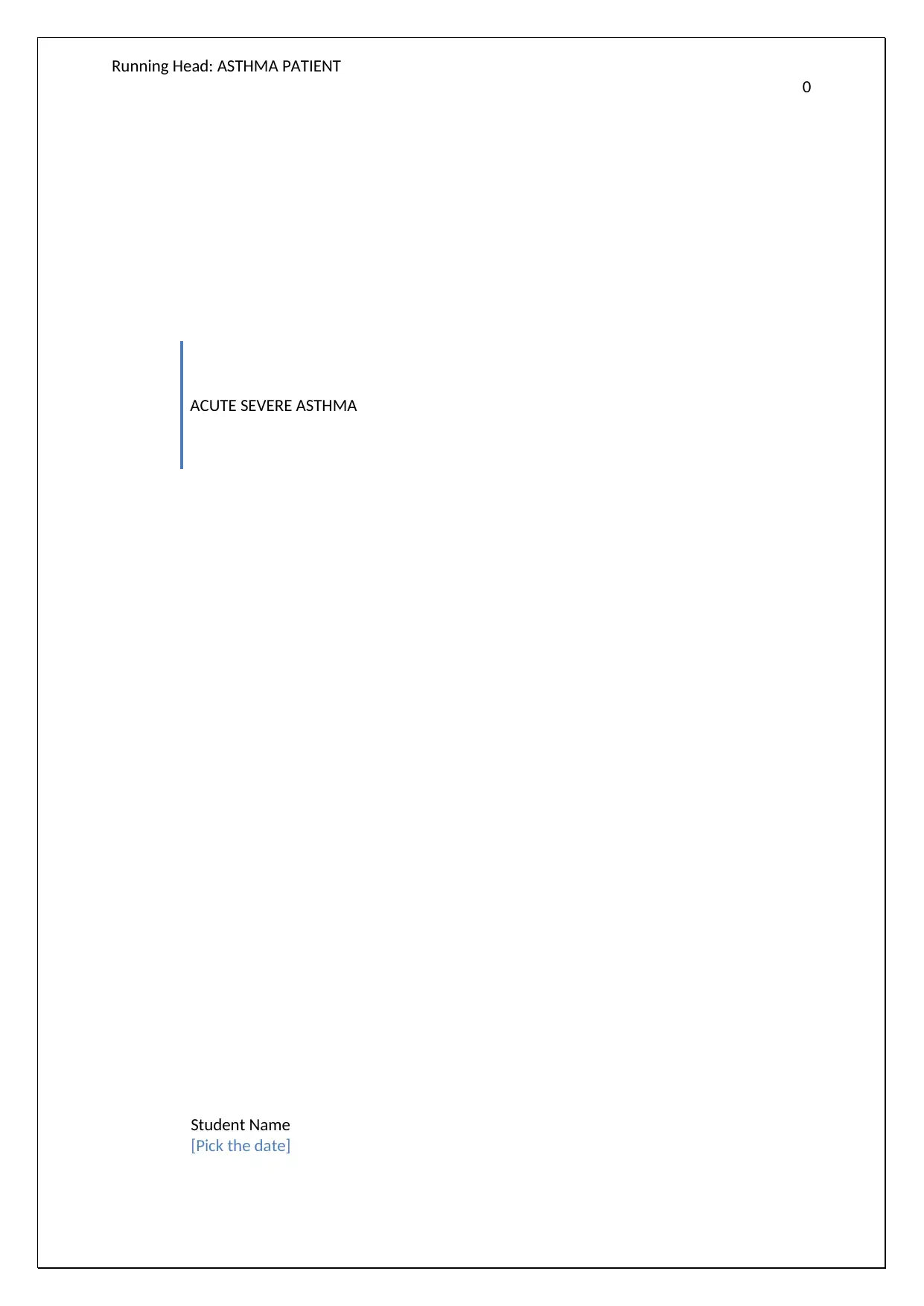
Running Head: ASTHMA PATIENT
0
ACUTE SEVERE ASTHMA
Student Name
[Pick the date]
0
ACUTE SEVERE ASTHMA
Student Name
[Pick the date]
Secure Best Marks with AI Grader
Need help grading? Try our AI Grader for instant feedback on your assignments.
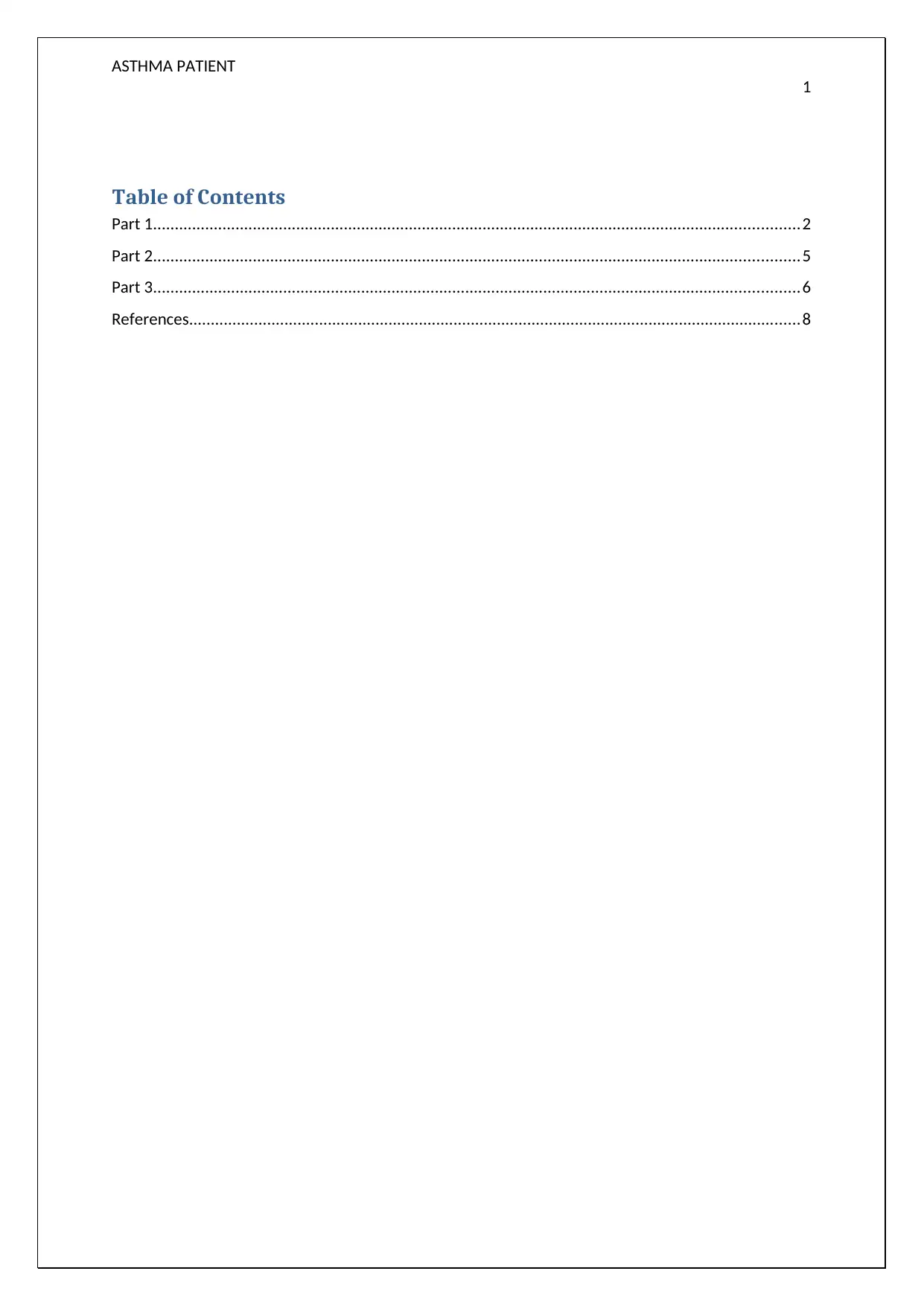
ASTHMA PATIENT
1
Table of Contents
Part 1.....................................................................................................................................................2
Part 2.....................................................................................................................................................5
Part 3.....................................................................................................................................................6
References.............................................................................................................................................8
1
Table of Contents
Part 1.....................................................................................................................................................2
Part 2.....................................................................................................................................................5
Part 3.....................................................................................................................................................6
References.............................................................................................................................................8
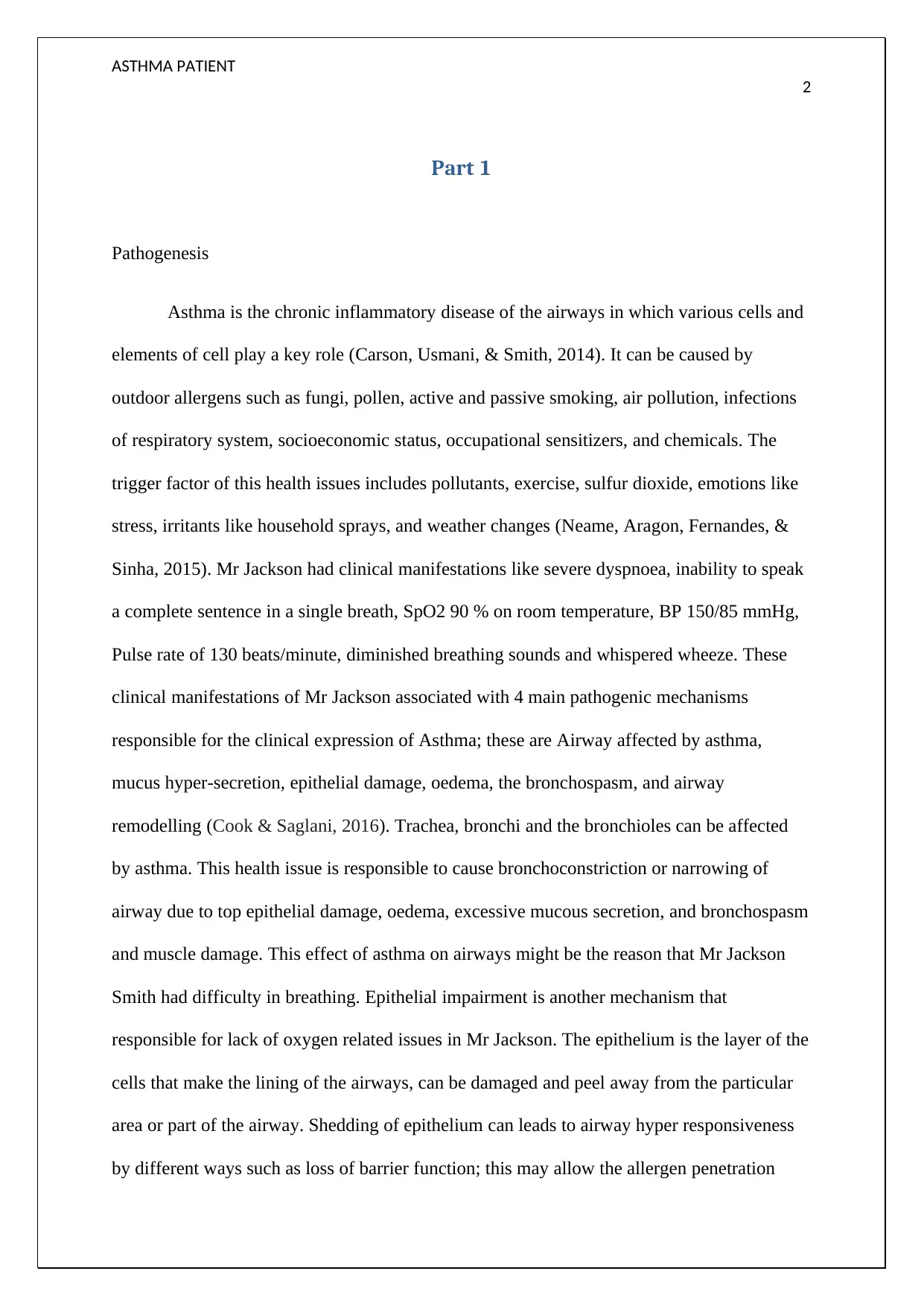
ASTHMA PATIENT
2
Part 1
Pathogenesis
Asthma is the chronic inflammatory disease of the airways in which various cells and
elements of cell play a key role (Carson, Usmani, & Smith, 2014). It can be caused by
outdoor allergens such as fungi, pollen, active and passive smoking, air pollution, infections
of respiratory system, socioeconomic status, occupational sensitizers, and chemicals. The
trigger factor of this health issues includes pollutants, exercise, sulfur dioxide, emotions like
stress, irritants like household sprays, and weather changes (Neame, Aragon, Fernandes, &
Sinha, 2015). Mr Jackson had clinical manifestations like severe dyspnoea, inability to speak
a complete sentence in a single breath, SpO2 90 % on room temperature, BP 150/85 mmHg,
Pulse rate of 130 beats/minute, diminished breathing sounds and whispered wheeze. These
clinical manifestations of Mr Jackson associated with 4 main pathogenic mechanisms
responsible for the clinical expression of Asthma; these are Airway affected by asthma,
mucus hyper-secretion, epithelial damage, oedema, the bronchospasm, and airway
remodelling (Cook & Saglani, 2016). Trachea, bronchi and the bronchioles can be affected
by asthma. This health issue is responsible to cause bronchoconstriction or narrowing of
airway due to top epithelial damage, oedema, excessive mucous secretion, and bronchospasm
and muscle damage. This effect of asthma on airways might be the reason that Mr Jackson
Smith had difficulty in breathing. Epithelial impairment is another mechanism that
responsible for lack of oxygen related issues in Mr Jackson. The epithelium is the layer of the
cells that make the lining of the airways, can be damaged and peel away from the particular
area or part of the airway. Shedding of epithelium can leads to airway hyper responsiveness
by different ways such as loss of barrier function; this may allow the allergen penetration
2
Part 1
Pathogenesis
Asthma is the chronic inflammatory disease of the airways in which various cells and
elements of cell play a key role (Carson, Usmani, & Smith, 2014). It can be caused by
outdoor allergens such as fungi, pollen, active and passive smoking, air pollution, infections
of respiratory system, socioeconomic status, occupational sensitizers, and chemicals. The
trigger factor of this health issues includes pollutants, exercise, sulfur dioxide, emotions like
stress, irritants like household sprays, and weather changes (Neame, Aragon, Fernandes, &
Sinha, 2015). Mr Jackson had clinical manifestations like severe dyspnoea, inability to speak
a complete sentence in a single breath, SpO2 90 % on room temperature, BP 150/85 mmHg,
Pulse rate of 130 beats/minute, diminished breathing sounds and whispered wheeze. These
clinical manifestations of Mr Jackson associated with 4 main pathogenic mechanisms
responsible for the clinical expression of Asthma; these are Airway affected by asthma,
mucus hyper-secretion, epithelial damage, oedema, the bronchospasm, and airway
remodelling (Cook & Saglani, 2016). Trachea, bronchi and the bronchioles can be affected
by asthma. This health issue is responsible to cause bronchoconstriction or narrowing of
airway due to top epithelial damage, oedema, excessive mucous secretion, and bronchospasm
and muscle damage. This effect of asthma on airways might be the reason that Mr Jackson
Smith had difficulty in breathing. Epithelial impairment is another mechanism that
responsible for lack of oxygen related issues in Mr Jackson. The epithelium is the layer of the
cells that make the lining of the airways, can be damaged and peel away from the particular
area or part of the airway. Shedding of epithelium can leads to airway hyper responsiveness
by different ways such as loss of barrier function; this may allow the allergen penetration
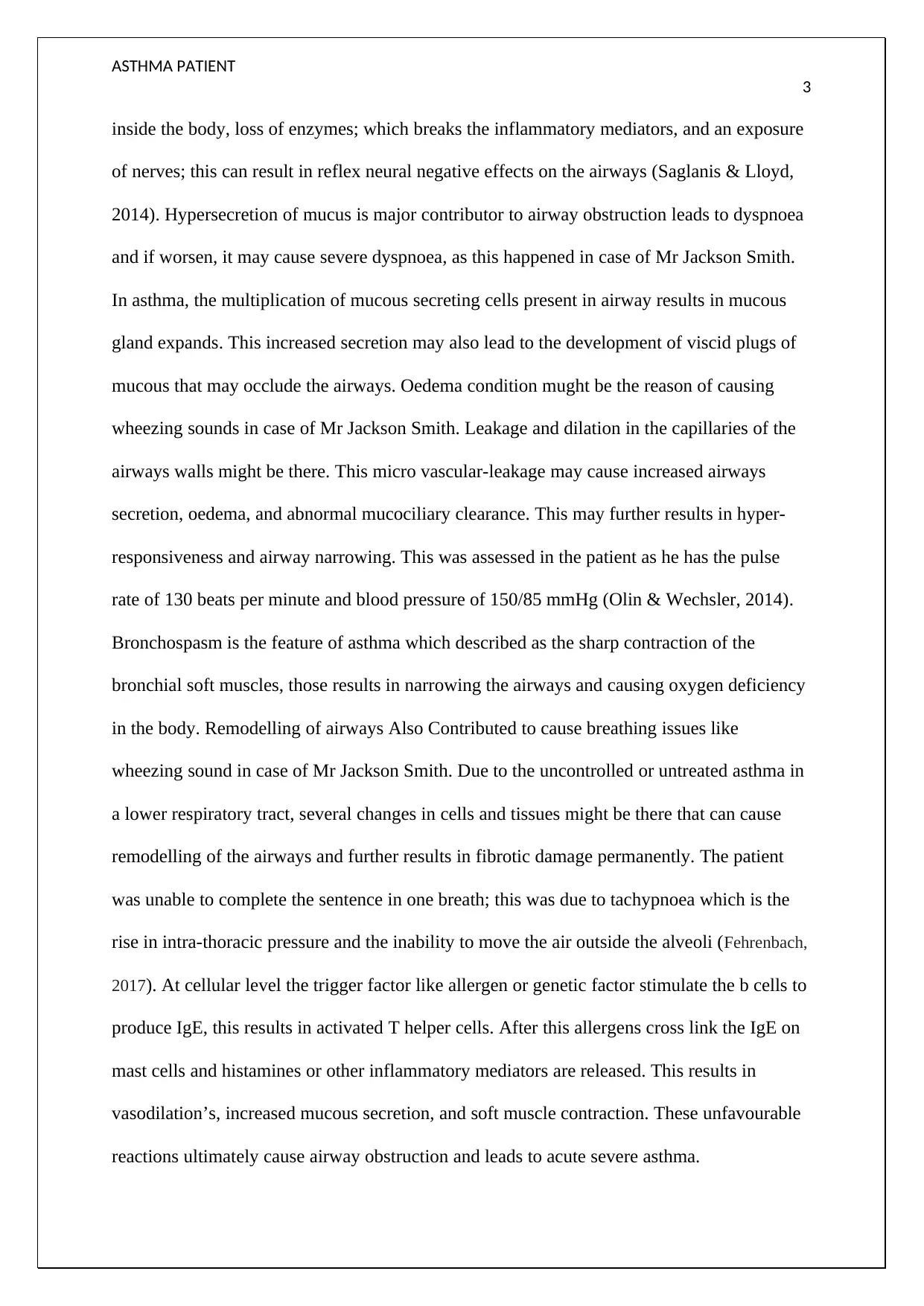
ASTHMA PATIENT
3
inside the body, loss of enzymes; which breaks the inflammatory mediators, and an exposure
of nerves; this can result in reflex neural negative effects on the airways (Saglanis & Lloyd,
2014). Hypersecretion of mucus is major contributor to airway obstruction leads to dyspnoea
and if worsen, it may cause severe dyspnoea, as this happened in case of Mr Jackson Smith.
In asthma, the multiplication of mucous secreting cells present in airway results in mucous
gland expands. This increased secretion may also lead to the development of viscid plugs of
mucous that may occlude the airways. Oedema condition mught be the reason of causing
wheezing sounds in case of Mr Jackson Smith. Leakage and dilation in the capillaries of the
airways walls might be there. This micro vascular-leakage may cause increased airways
secretion, oedema, and abnormal mucociliary clearance. This may further results in hyper-
responsiveness and airway narrowing. This was assessed in the patient as he has the pulse
rate of 130 beats per minute and blood pressure of 150/85 mmHg (Olin & Wechsler, 2014).
Bronchospasm is the feature of asthma which described as the sharp contraction of the
bronchial soft muscles, those results in narrowing the airways and causing oxygen deficiency
in the body. Remodelling of airways Also Contributed to cause breathing issues like
wheezing sound in case of Mr Jackson Smith. Due to the uncontrolled or untreated asthma in
a lower respiratory tract, several changes in cells and tissues might be there that can cause
remodelling of the airways and further results in fibrotic damage permanently. The patient
was unable to complete the sentence in one breath; this was due to tachypnoea which is the
rise in intra-thoracic pressure and the inability to move the air outside the alveoli (Fehrenbach,
2017). At cellular level the trigger factor like allergen or genetic factor stimulate the b cells to
produce IgE, this results in activated T helper cells. After this allergens cross link the IgE on
mast cells and histamines or other inflammatory mediators are released. This results in
vasodilation’s, increased mucous secretion, and soft muscle contraction. These unfavourable
reactions ultimately cause airway obstruction and leads to acute severe asthma.
3
inside the body, loss of enzymes; which breaks the inflammatory mediators, and an exposure
of nerves; this can result in reflex neural negative effects on the airways (Saglanis & Lloyd,
2014). Hypersecretion of mucus is major contributor to airway obstruction leads to dyspnoea
and if worsen, it may cause severe dyspnoea, as this happened in case of Mr Jackson Smith.
In asthma, the multiplication of mucous secreting cells present in airway results in mucous
gland expands. This increased secretion may also lead to the development of viscid plugs of
mucous that may occlude the airways. Oedema condition mught be the reason of causing
wheezing sounds in case of Mr Jackson Smith. Leakage and dilation in the capillaries of the
airways walls might be there. This micro vascular-leakage may cause increased airways
secretion, oedema, and abnormal mucociliary clearance. This may further results in hyper-
responsiveness and airway narrowing. This was assessed in the patient as he has the pulse
rate of 130 beats per minute and blood pressure of 150/85 mmHg (Olin & Wechsler, 2014).
Bronchospasm is the feature of asthma which described as the sharp contraction of the
bronchial soft muscles, those results in narrowing the airways and causing oxygen deficiency
in the body. Remodelling of airways Also Contributed to cause breathing issues like
wheezing sound in case of Mr Jackson Smith. Due to the uncontrolled or untreated asthma in
a lower respiratory tract, several changes in cells and tissues might be there that can cause
remodelling of the airways and further results in fibrotic damage permanently. The patient
was unable to complete the sentence in one breath; this was due to tachypnoea which is the
rise in intra-thoracic pressure and the inability to move the air outside the alveoli (Fehrenbach,
2017). At cellular level the trigger factor like allergen or genetic factor stimulate the b cells to
produce IgE, this results in activated T helper cells. After this allergens cross link the IgE on
mast cells and histamines or other inflammatory mediators are released. This results in
vasodilation’s, increased mucous secretion, and soft muscle contraction. These unfavourable
reactions ultimately cause airway obstruction and leads to acute severe asthma.
Secure Best Marks with AI Grader
Need help grading? Try our AI Grader for instant feedback on your assignments.
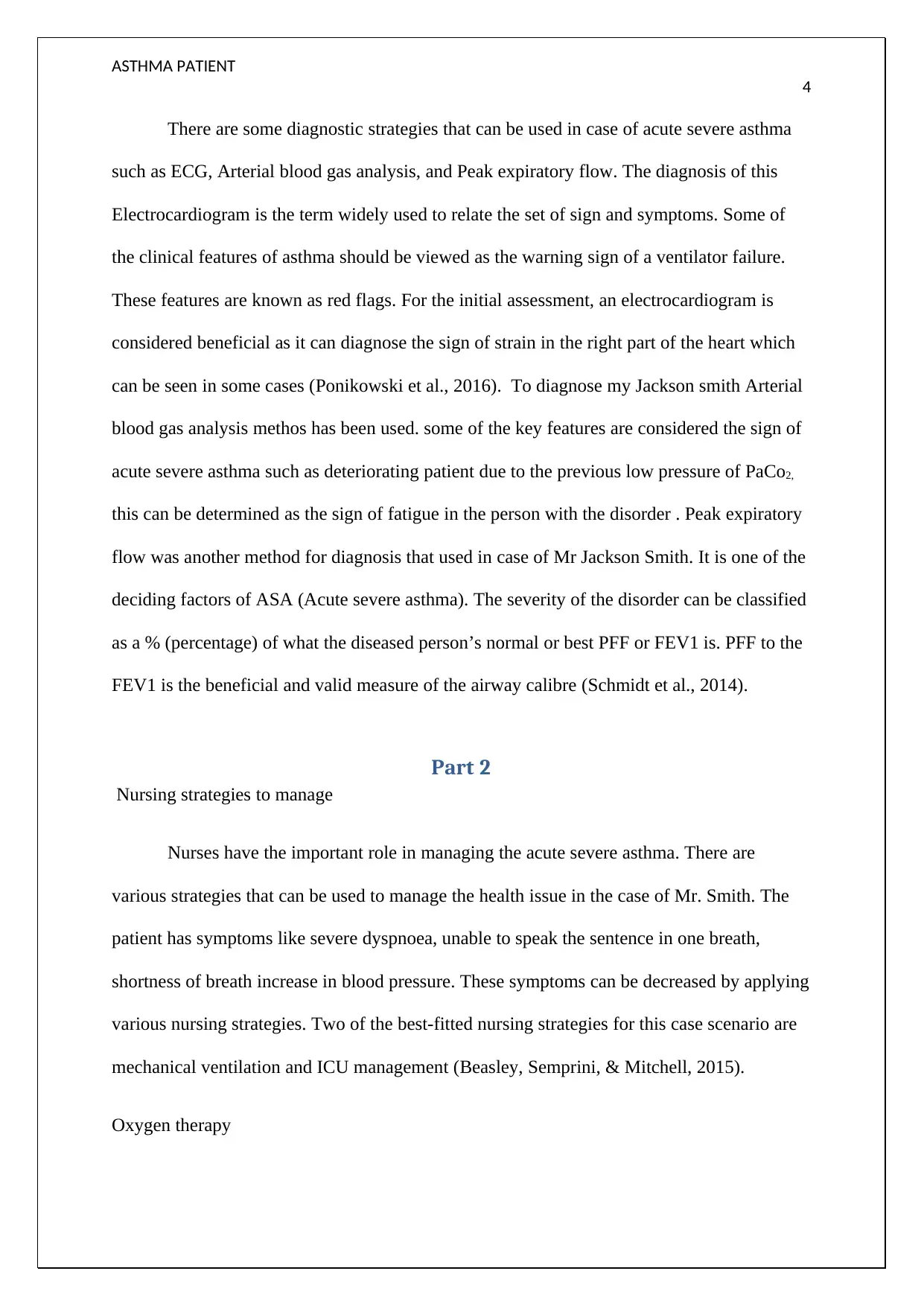
ASTHMA PATIENT
4
There are some diagnostic strategies that can be used in case of acute severe asthma
such as ECG, Arterial blood gas analysis, and Peak expiratory flow. The diagnosis of this
Electrocardiogram is the term widely used to relate the set of sign and symptoms. Some of
the clinical features of asthma should be viewed as the warning sign of a ventilator failure.
These features are known as red flags. For the initial assessment, an electrocardiogram is
considered beneficial as it can diagnose the sign of strain in the right part of the heart which
can be seen in some cases (Ponikowski et al., 2016). To diagnose my Jackson smith Arterial
blood gas analysis methos has been used. some of the key features are considered the sign of
acute severe asthma such as deteriorating patient due to the previous low pressure of PaCo2,
this can be determined as the sign of fatigue in the person with the disorder . Peak expiratory
flow was another method for diagnosis that used in case of Mr Jackson Smith. It is one of the
deciding factors of ASA (Acute severe asthma). The severity of the disorder can be classified
as a % (percentage) of what the diseased person’s normal or best PFF or FEV1 is. PFF to the
FEV1 is the beneficial and valid measure of the airway calibre (Schmidt et al., 2014).
Part 2
Nursing strategies to manage
Nurses have the important role in managing the acute severe asthma. There are
various strategies that can be used to manage the health issue in the case of Mr. Smith. The
patient has symptoms like severe dyspnoea, unable to speak the sentence in one breath,
shortness of breath increase in blood pressure. These symptoms can be decreased by applying
various nursing strategies. Two of the best-fitted nursing strategies for this case scenario are
mechanical ventilation and ICU management (Beasley, Semprini, & Mitchell, 2015).
Oxygen therapy
4
There are some diagnostic strategies that can be used in case of acute severe asthma
such as ECG, Arterial blood gas analysis, and Peak expiratory flow. The diagnosis of this
Electrocardiogram is the term widely used to relate the set of sign and symptoms. Some of
the clinical features of asthma should be viewed as the warning sign of a ventilator failure.
These features are known as red flags. For the initial assessment, an electrocardiogram is
considered beneficial as it can diagnose the sign of strain in the right part of the heart which
can be seen in some cases (Ponikowski et al., 2016). To diagnose my Jackson smith Arterial
blood gas analysis methos has been used. some of the key features are considered the sign of
acute severe asthma such as deteriorating patient due to the previous low pressure of PaCo2,
this can be determined as the sign of fatigue in the person with the disorder . Peak expiratory
flow was another method for diagnosis that used in case of Mr Jackson Smith. It is one of the
deciding factors of ASA (Acute severe asthma). The severity of the disorder can be classified
as a % (percentage) of what the diseased person’s normal or best PFF or FEV1 is. PFF to the
FEV1 is the beneficial and valid measure of the airway calibre (Schmidt et al., 2014).
Part 2
Nursing strategies to manage
Nurses have the important role in managing the acute severe asthma. There are
various strategies that can be used to manage the health issue in the case of Mr. Smith. The
patient has symptoms like severe dyspnoea, unable to speak the sentence in one breath,
shortness of breath increase in blood pressure. These symptoms can be decreased by applying
various nursing strategies. Two of the best-fitted nursing strategies for this case scenario are
mechanical ventilation and ICU management (Beasley, Semprini, & Mitchell, 2015).
Oxygen therapy
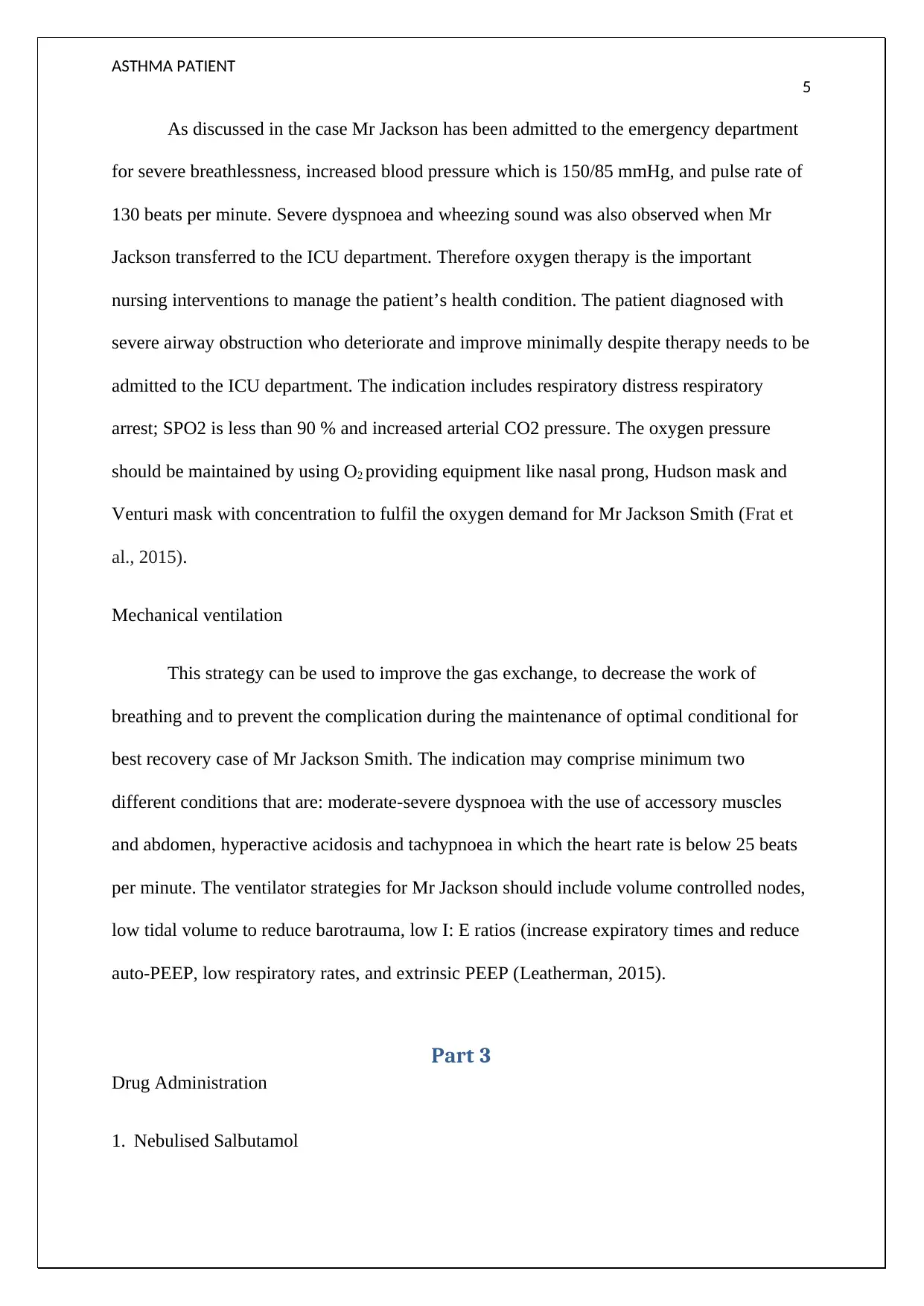
ASTHMA PATIENT
5
As discussed in the case Mr Jackson has been admitted to the emergency department
for severe breathlessness, increased blood pressure which is 150/85 mmHg, and pulse rate of
130 beats per minute. Severe dyspnoea and wheezing sound was also observed when Mr
Jackson transferred to the ICU department. Therefore oxygen therapy is the important
nursing interventions to manage the patient’s health condition. The patient diagnosed with
severe airway obstruction who deteriorate and improve minimally despite therapy needs to be
admitted to the ICU department. The indication includes respiratory distress respiratory
arrest; SPO2 is less than 90 % and increased arterial CO2 pressure. The oxygen pressure
should be maintained by using O2 providing equipment like nasal prong, Hudson mask and
Venturi mask with concentration to fulfil the oxygen demand for Mr Jackson Smith (Frat et
al., 2015).
Mechanical ventilation
This strategy can be used to improve the gas exchange, to decrease the work of
breathing and to prevent the complication during the maintenance of optimal conditional for
best recovery case of Mr Jackson Smith. The indication may comprise minimum two
different conditions that are: moderate-severe dyspnoea with the use of accessory muscles
and abdomen, hyperactive acidosis and tachypnoea in which the heart rate is below 25 beats
per minute. The ventilator strategies for Mr Jackson should include volume controlled nodes,
low tidal volume to reduce barotrauma, low I: E ratios (increase expiratory times and reduce
auto-PEEP, low respiratory rates, and extrinsic PEEP (Leatherman, 2015).
Part 3
Drug Administration
1. Nebulised Salbutamol
5
As discussed in the case Mr Jackson has been admitted to the emergency department
for severe breathlessness, increased blood pressure which is 150/85 mmHg, and pulse rate of
130 beats per minute. Severe dyspnoea and wheezing sound was also observed when Mr
Jackson transferred to the ICU department. Therefore oxygen therapy is the important
nursing interventions to manage the patient’s health condition. The patient diagnosed with
severe airway obstruction who deteriorate and improve minimally despite therapy needs to be
admitted to the ICU department. The indication includes respiratory distress respiratory
arrest; SPO2 is less than 90 % and increased arterial CO2 pressure. The oxygen pressure
should be maintained by using O2 providing equipment like nasal prong, Hudson mask and
Venturi mask with concentration to fulfil the oxygen demand for Mr Jackson Smith (Frat et
al., 2015).
Mechanical ventilation
This strategy can be used to improve the gas exchange, to decrease the work of
breathing and to prevent the complication during the maintenance of optimal conditional for
best recovery case of Mr Jackson Smith. The indication may comprise minimum two
different conditions that are: moderate-severe dyspnoea with the use of accessory muscles
and abdomen, hyperactive acidosis and tachypnoea in which the heart rate is below 25 beats
per minute. The ventilator strategies for Mr Jackson should include volume controlled nodes,
low tidal volume to reduce barotrauma, low I: E ratios (increase expiratory times and reduce
auto-PEEP, low respiratory rates, and extrinsic PEEP (Leatherman, 2015).
Part 3
Drug Administration
1. Nebulised Salbutamol
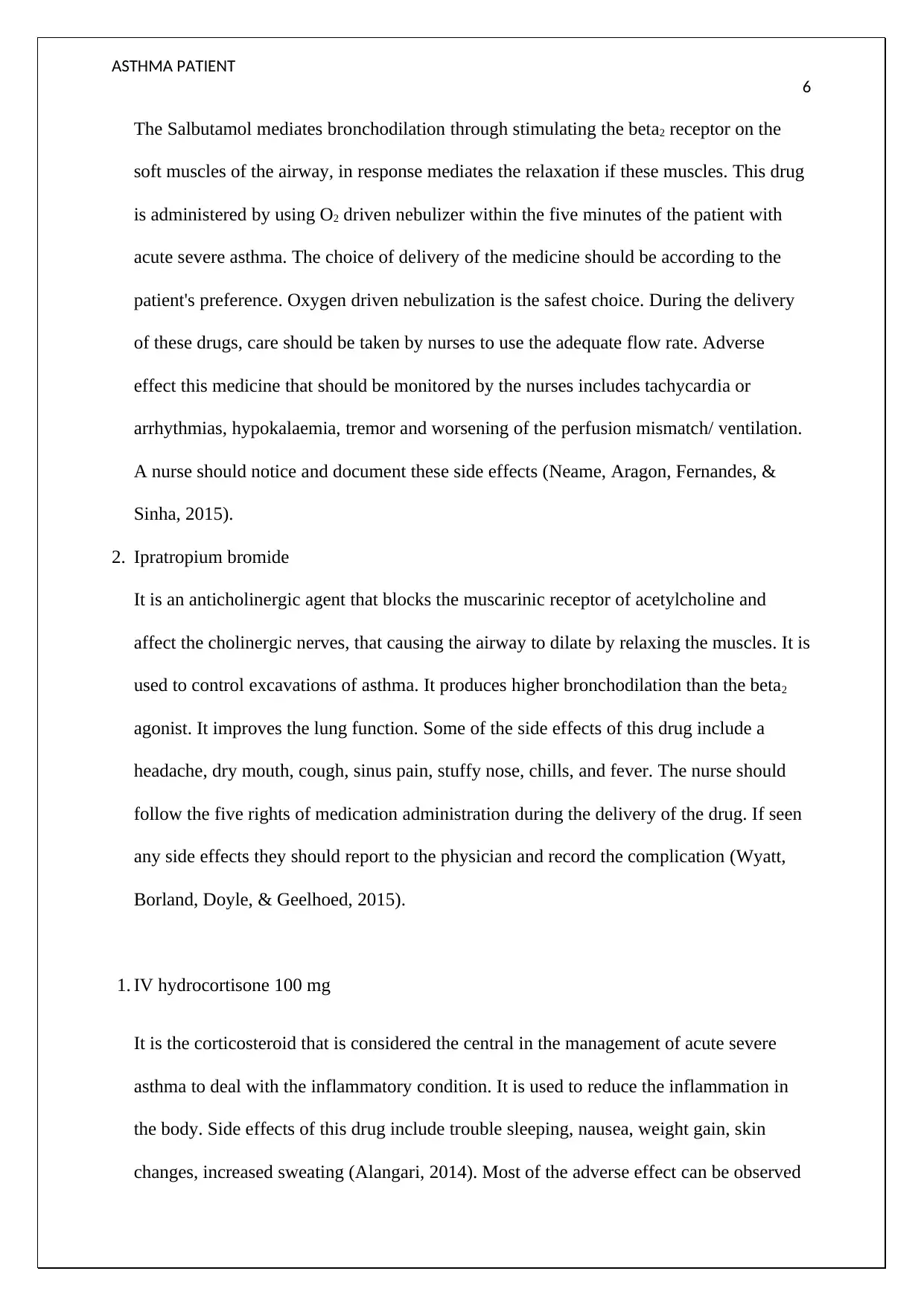
ASTHMA PATIENT
6
The Salbutamol mediates bronchodilation through stimulating the beta2 receptor on the
soft muscles of the airway, in response mediates the relaxation if these muscles. This drug
is administered by using O2 driven nebulizer within the five minutes of the patient with
acute severe asthma. The choice of delivery of the medicine should be according to the
patient's preference. Oxygen driven nebulization is the safest choice. During the delivery
of these drugs, care should be taken by nurses to use the adequate flow rate. Adverse
effect this medicine that should be monitored by the nurses includes tachycardia or
arrhythmias, hypokalaemia, tremor and worsening of the perfusion mismatch/ ventilation.
A nurse should notice and document these side effects (Neame, Aragon, Fernandes, &
Sinha, 2015).
2. Ipratropium bromide
It is an anticholinergic agent that blocks the muscarinic receptor of acetylcholine and
affect the cholinergic nerves, that causing the airway to dilate by relaxing the muscles. It is
used to control excavations of asthma. It produces higher bronchodilation than the beta2
agonist. It improves the lung function. Some of the side effects of this drug include a
headache, dry mouth, cough, sinus pain, stuffy nose, chills, and fever. The nurse should
follow the five rights of medication administration during the delivery of the drug. If seen
any side effects they should report to the physician and record the complication (Wyatt,
Borland, Doyle, & Geelhoed, 2015).
1. IV hydrocortisone 100 mg
It is the corticosteroid that is considered the central in the management of acute severe
asthma to deal with the inflammatory condition. It is used to reduce the inflammation in
the body. Side effects of this drug include trouble sleeping, nausea, weight gain, skin
changes, increased sweating (Alangari, 2014). Most of the adverse effect can be observed
6
The Salbutamol mediates bronchodilation through stimulating the beta2 receptor on the
soft muscles of the airway, in response mediates the relaxation if these muscles. This drug
is administered by using O2 driven nebulizer within the five minutes of the patient with
acute severe asthma. The choice of delivery of the medicine should be according to the
patient's preference. Oxygen driven nebulization is the safest choice. During the delivery
of these drugs, care should be taken by nurses to use the adequate flow rate. Adverse
effect this medicine that should be monitored by the nurses includes tachycardia or
arrhythmias, hypokalaemia, tremor and worsening of the perfusion mismatch/ ventilation.
A nurse should notice and document these side effects (Neame, Aragon, Fernandes, &
Sinha, 2015).
2. Ipratropium bromide
It is an anticholinergic agent that blocks the muscarinic receptor of acetylcholine and
affect the cholinergic nerves, that causing the airway to dilate by relaxing the muscles. It is
used to control excavations of asthma. It produces higher bronchodilation than the beta2
agonist. It improves the lung function. Some of the side effects of this drug include a
headache, dry mouth, cough, sinus pain, stuffy nose, chills, and fever. The nurse should
follow the five rights of medication administration during the delivery of the drug. If seen
any side effects they should report to the physician and record the complication (Wyatt,
Borland, Doyle, & Geelhoed, 2015).
1. IV hydrocortisone 100 mg
It is the corticosteroid that is considered the central in the management of acute severe
asthma to deal with the inflammatory condition. It is used to reduce the inflammation in
the body. Side effects of this drug include trouble sleeping, nausea, weight gain, skin
changes, increased sweating (Alangari, 2014). Most of the adverse effect can be observed
Paraphrase This Document
Need a fresh take? Get an instant paraphrase of this document with our AI Paraphraser
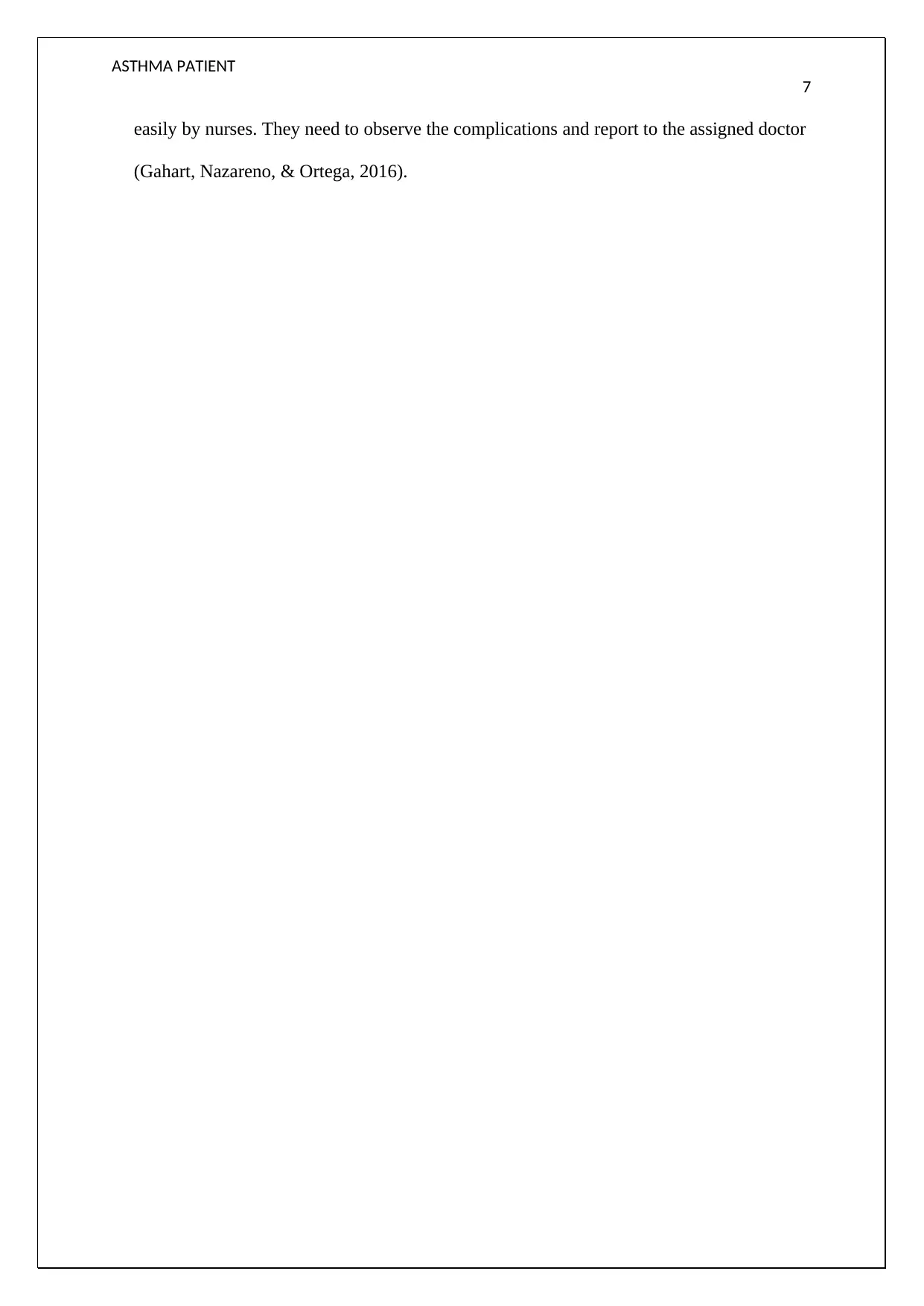
ASTHMA PATIENT
7
easily by nurses. They need to observe the complications and report to the assigned doctor
(Gahart, Nazareno, & Ortega, 2016).
7
easily by nurses. They need to observe the complications and report to the assigned doctor
(Gahart, Nazareno, & Ortega, 2016).
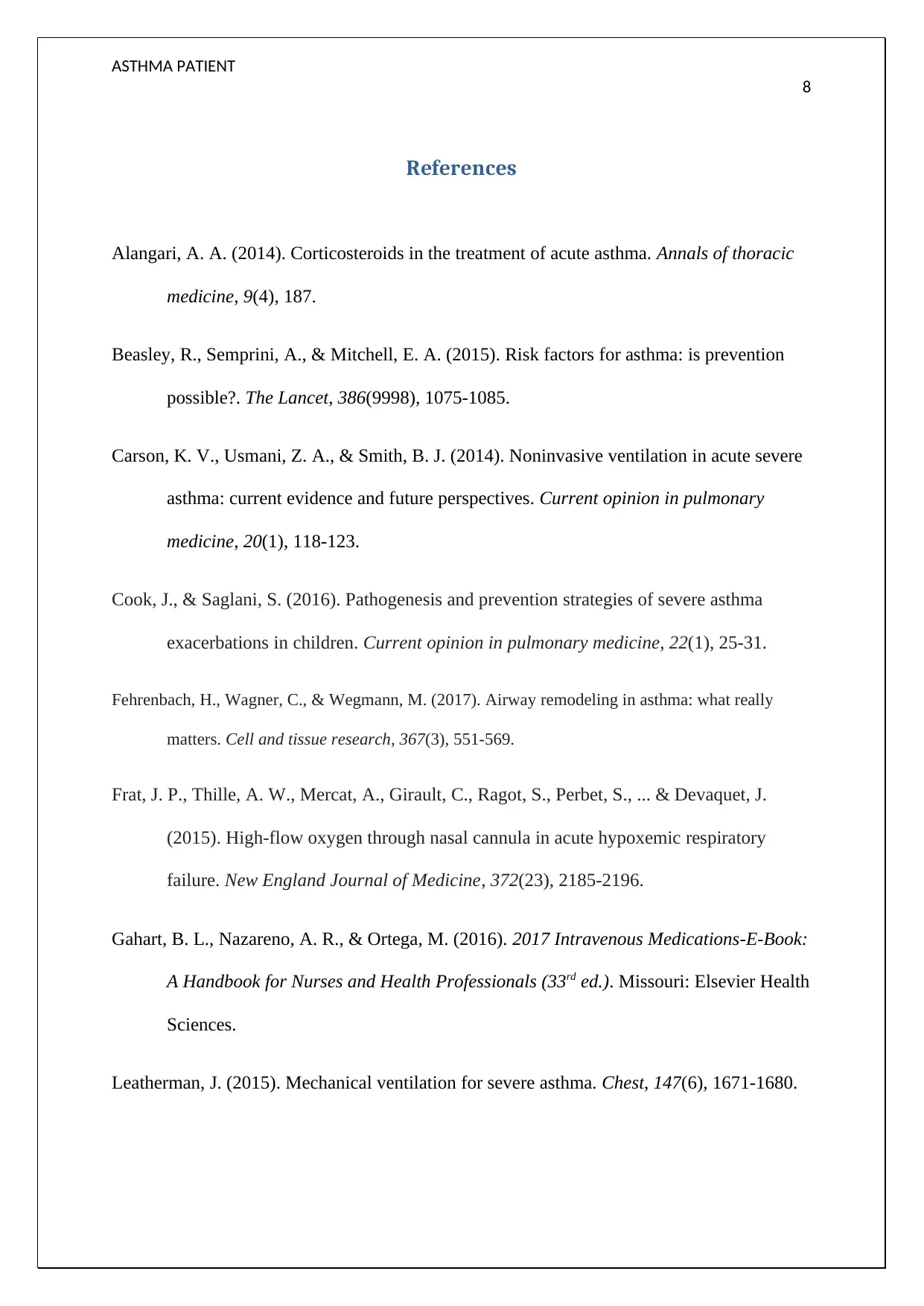
ASTHMA PATIENT
8
References
Alangari, A. A. (2014). Corticosteroids in the treatment of acute asthma. Annals of thoracic
medicine, 9(4), 187.
Beasley, R., Semprini, A., & Mitchell, E. A. (2015). Risk factors for asthma: is prevention
possible?. The Lancet, 386(9998), 1075-1085.
Carson, K. V., Usmani, Z. A., & Smith, B. J. (2014). Noninvasive ventilation in acute severe
asthma: current evidence and future perspectives. Current opinion in pulmonary
medicine, 20(1), 118-123.
Cook, J., & Saglani, S. (2016). Pathogenesis and prevention strategies of severe asthma
exacerbations in children. Current opinion in pulmonary medicine, 22(1), 25-31.
Fehrenbach, H., Wagner, C., & Wegmann, M. (2017). Airway remodeling in asthma: what really
matters. Cell and tissue research, 367(3), 551-569.
Frat, J. P., Thille, A. W., Mercat, A., Girault, C., Ragot, S., Perbet, S., ... & Devaquet, J.
(2015). High-flow oxygen through nasal cannula in acute hypoxemic respiratory
failure. New England Journal of Medicine, 372(23), 2185-2196.
Gahart, B. L., Nazareno, A. R., & Ortega, M. (2016). 2017 Intravenous Medications-E-Book:
A Handbook for Nurses and Health Professionals (33rd ed.). Missouri: Elsevier Health
Sciences.
Leatherman, J. (2015). Mechanical ventilation for severe asthma. Chest, 147(6), 1671-1680.
8
References
Alangari, A. A. (2014). Corticosteroids in the treatment of acute asthma. Annals of thoracic
medicine, 9(4), 187.
Beasley, R., Semprini, A., & Mitchell, E. A. (2015). Risk factors for asthma: is prevention
possible?. The Lancet, 386(9998), 1075-1085.
Carson, K. V., Usmani, Z. A., & Smith, B. J. (2014). Noninvasive ventilation in acute severe
asthma: current evidence and future perspectives. Current opinion in pulmonary
medicine, 20(1), 118-123.
Cook, J., & Saglani, S. (2016). Pathogenesis and prevention strategies of severe asthma
exacerbations in children. Current opinion in pulmonary medicine, 22(1), 25-31.
Fehrenbach, H., Wagner, C., & Wegmann, M. (2017). Airway remodeling in asthma: what really
matters. Cell and tissue research, 367(3), 551-569.
Frat, J. P., Thille, A. W., Mercat, A., Girault, C., Ragot, S., Perbet, S., ... & Devaquet, J.
(2015). High-flow oxygen through nasal cannula in acute hypoxemic respiratory
failure. New England Journal of Medicine, 372(23), 2185-2196.
Gahart, B. L., Nazareno, A. R., & Ortega, M. (2016). 2017 Intravenous Medications-E-Book:
A Handbook for Nurses and Health Professionals (33rd ed.). Missouri: Elsevier Health
Sciences.
Leatherman, J. (2015). Mechanical ventilation for severe asthma. Chest, 147(6), 1671-1680.
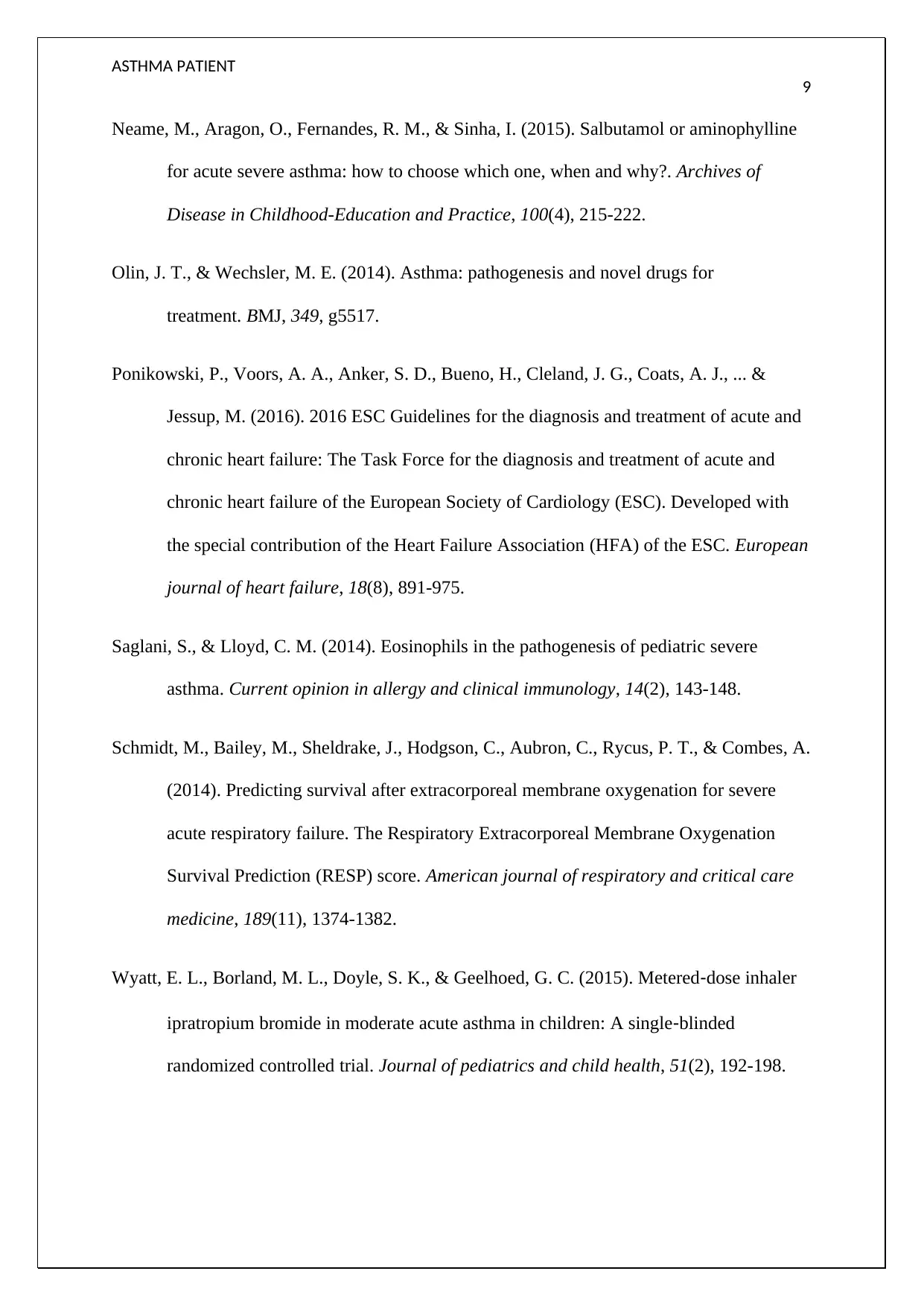
ASTHMA PATIENT
9
Neame, M., Aragon, O., Fernandes, R. M., & Sinha, I. (2015). Salbutamol or aminophylline
for acute severe asthma: how to choose which one, when and why?. Archives of
Disease in Childhood-Education and Practice, 100(4), 215-222.
Olin, J. T., & Wechsler, M. E. (2014). Asthma: pathogenesis and novel drugs for
treatment. BMJ, 349, g5517.
Ponikowski, P., Voors, A. A., Anker, S. D., Bueno, H., Cleland, J. G., Coats, A. J., ... &
Jessup, M. (2016). 2016 ESC Guidelines for the diagnosis and treatment of acute and
chronic heart failure: The Task Force for the diagnosis and treatment of acute and
chronic heart failure of the European Society of Cardiology (ESC). Developed with
the special contribution of the Heart Failure Association (HFA) of the ESC. European
journal of heart failure, 18(8), 891-975.
Saglani, S., & Lloyd, C. M. (2014). Eosinophils in the pathogenesis of pediatric severe
asthma. Current opinion in allergy and clinical immunology, 14(2), 143-148.
Schmidt, M., Bailey, M., Sheldrake, J., Hodgson, C., Aubron, C., Rycus, P. T., & Combes, A.
(2014). Predicting survival after extracorporeal membrane oxygenation for severe
acute respiratory failure. The Respiratory Extracorporeal Membrane Oxygenation
Survival Prediction (RESP) score. American journal of respiratory and critical care
medicine, 189(11), 1374-1382.
Wyatt, E. L., Borland, M. L., Doyle, S. K., & Geelhoed, G. C. (2015). Metered‐dose inhaler
ipratropium bromide in moderate acute asthma in children: A single‐blinded
randomized controlled trial. Journal of pediatrics and child health, 51(2), 192-198.
9
Neame, M., Aragon, O., Fernandes, R. M., & Sinha, I. (2015). Salbutamol or aminophylline
for acute severe asthma: how to choose which one, when and why?. Archives of
Disease in Childhood-Education and Practice, 100(4), 215-222.
Olin, J. T., & Wechsler, M. E. (2014). Asthma: pathogenesis and novel drugs for
treatment. BMJ, 349, g5517.
Ponikowski, P., Voors, A. A., Anker, S. D., Bueno, H., Cleland, J. G., Coats, A. J., ... &
Jessup, M. (2016). 2016 ESC Guidelines for the diagnosis and treatment of acute and
chronic heart failure: The Task Force for the diagnosis and treatment of acute and
chronic heart failure of the European Society of Cardiology (ESC). Developed with
the special contribution of the Heart Failure Association (HFA) of the ESC. European
journal of heart failure, 18(8), 891-975.
Saglani, S., & Lloyd, C. M. (2014). Eosinophils in the pathogenesis of pediatric severe
asthma. Current opinion in allergy and clinical immunology, 14(2), 143-148.
Schmidt, M., Bailey, M., Sheldrake, J., Hodgson, C., Aubron, C., Rycus, P. T., & Combes, A.
(2014). Predicting survival after extracorporeal membrane oxygenation for severe
acute respiratory failure. The Respiratory Extracorporeal Membrane Oxygenation
Survival Prediction (RESP) score. American journal of respiratory and critical care
medicine, 189(11), 1374-1382.
Wyatt, E. L., Borland, M. L., Doyle, S. K., & Geelhoed, G. C. (2015). Metered‐dose inhaler
ipratropium bromide in moderate acute asthma in children: A single‐blinded
randomized controlled trial. Journal of pediatrics and child health, 51(2), 192-198.
1 out of 10
Related Documents
Your All-in-One AI-Powered Toolkit for Academic Success.
+13062052269
info@desklib.com
Available 24*7 on WhatsApp / Email
![[object Object]](/_next/static/media/star-bottom.7253800d.svg)
Unlock your academic potential
© 2024 | Zucol Services PVT LTD | All rights reserved.


